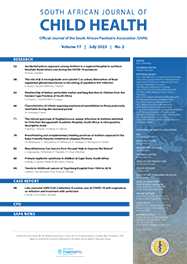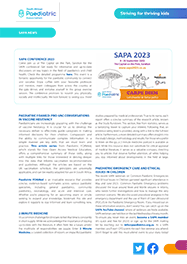Atypical teratoid/rhabdoid tumour in a supratentorial location: A report of two cases
1 Department of Diagnostic Radiology, Faculty of Health Sciences, University of the Witwatersrand, Johannesburg, South Africa
2 Department of Diagnostic Radiology, Faculty of Health Sciences, University of Cape Town, South Africa
3 Department of Anatomical Pathology, Faculty of Health Sciences, University of the Witwatersrand, Johannesburg, South Africa
4 Division of Anatomical Pathology, Faculty of Health Sciences, University of Cape Town, South Africa
Corresponding author: N Mahomed (nasreen.mahomed@wits.ac.za)
Atypical teratoid/rhabdoid tumour of the central nervous system
is a rare, highly aggressive childhood malignancy. The age of
presentation is usually <2 years, but this tumour may occur
in other age groups. The typical location is the posterior
fossa, with supratentorial origin less common. We present two
cases of atypical teratoid/rhabdoid tumours, with the
suprasellar location of one case proving to be a diagnostic
radiological challenge.
S Afr J CH 2014;8(4):159-161. DOI:10.7196/SAJCH.655
Atypical teratoid/rhabdoid tumour of the central nervous system
(CNS) is a rare, highly aggressive childhood malignancy.1
,
2 The
prognosis is generally poor.3
,
4 The typical location is
the posterior fossa; less than a third occur supratentorially,5 and most
are off the midline.1 We present two patients with
supratentorial location (one suprasellar, which is very
unusual), both demonstrating a peripheral rim of restricted
diffusion on magnetic resonance imaging (MRI), an important
diagnostic feature of atypical teratoid/rhabdoid tumours.1
,
2
,
4
Case 1
A 3-month-old girl presented to our institution with a
history of convulsions. Postcontrast MRI demonstrated an
inhomogeneously enhancing, centrally necrotic suprasellar
mass, which extended into the frontal horn of the lateral
ventricle, complicated by obstructive hydrocephalus (Figs 1
and 2). Diffusion-weighted imaging
(DWI)/apparent diffusion coefficient (ADC) mapping
demonstrated a peripheral ring of restricted diffusion within
the tumour. ‘Blooming’ of areas on gradient echo was confirmed
as calcification on a computed tomography (CT) scan performed
after ventriculoperitoneal shunt insertion (Fig.
3). No spinal metastases were demonstrated on MRI.
Fig. 1. Sagittal T1-weighted magnetic resonance image post contrast demonstrating a midline, inhomogeneous, rim-enhancing mass extending into the sella turcica and frontal horn of the lateral ventricle. Central areas of non-enhancing low intensity are suggestive of necrosis. Hydrocephalus has developed as a complication of the mass.
Fig. 2. Axial T1-weighted magnetic resonance image post contrast demonstrating an inhomogeneously rim-enhancing supratentorial mass extending into the frontal horn of the right lateral ventricle, complicated by an acute obstructive hydrocephalus associated with trans-ependymal oedema.
Fig. 3. Axial post-contrast computed tomography scan of the brain, after ventriculoperitoneal shunt insertion, demonstrates a poorly enhancing, predominantly cystic mass with areas of calcification. The ventriculoperitoneal shunting is complicated by bilateral subdural surface collections.
Pathological assessment confirmed the
presence of a high-grade malignant neoplasm with foci of
coagulative tumour necrosis and frequent mitotic figures. The
architecture of the tumour varied from well-defined tumour
cell nests to haphazardly distributed spindle cells. Some
tumour cells displayed distinct rhabdoid morphology (Fig. 4)
characterised by abundant eosinophilic cytoplasm with
intracytoplasmic inclusions, eccentrically displaced vesicular
nuclei and prominent nucleoli. Histopathological diagnosis of
an atypical teratoid/rhabdoid tumour (World Health
Organization (WHO) grade IV) was confirmed by diffuse
immunoreactivity for vimentin (an intermediate filament),
focal cytoplasmic and membrane staining with epithelial
membrane antigen (EMA), and focal staining with smooth-muscle
actin (SMA). Ki-67 immunohistochemistry revealed a high
proliferation index of ~ 50%.
Fig. 4. H&E-stained section (400× magnification) displaying focal rhabdoid morphological features with prominent nucleolus, and eccentric displacement of the nucleus by eosinophilic cytoplasm in which an intracytoplasmic inclusion is found.
Glial fibrillary acidic protein (GFAP), neurofilament, cytokeratin and desmin immunohistochemistry were negative. Immunohistochemistry for germ cell markers was also negative.
The patient became comatose and died shortly after ventriculoperitoneal shunting, prior to any definitive treatment.
Case 2
A 2-year-old girl presented with convulsions and new-onset
left-sided weakness. MRI revealed a heterogeneous mass with
central necrosis in the right parietal lobe, causing a mass
effect on the right lateral ventricle and complicated by
obstructive hydrocephalus (Fig. 5). The mass enhanced
heterogeneously post contrast, with a central necrotic
component. A peripheral rim of restricted diffusion was
demonstrated on DWI/ADC mapping. CSF seeding of the tumour was
detected along the ventral surface of the brainstem and on the
cerebellopontine angle cisterns, the anterolateral temporal
lobes and posterior fossa, the leptomeninges and the cauda
equina of the spine (Fig. 6).
Fig. 5. Axial T2-weighted magnetic resonance image demonstrating a heterogeneous right parietal mass with central necrosis.
Fig. 6. Sagittal T2-weighted magnetic resonance image of the spine showing nodular tumour foci in the posterior fossa (closed arrow), leptomeninges and cauda equina of the spine (open arrow).
An intra-operative diagnosis of atypical
teratoid/rhabdoid tumour was made based on the morphology of the
brain smears. The cells had round eccentric nuclei, conspicuous
nucleoli, abundant eosinophilic cytoplasm and paranuclear
inclusions (Fig. 7). Paraffin sections confirmed
the diagnosis and showed prominent vessels, perivascular
pseudorosettes and areas of dystrophic calcification. On
immunohistochemical staining, the tumour was strongly positive
for vimentin, GFAP and EMA. The final pathological diagnosis was
an atypical teratoid/rhabdoid tumour (WHO grade IV).
Fig. 7. Intra-operative brain smear demonstrating rhabdoid cells with eccentric nuclei, vesicular chromatin, conspicuous nucleoli and eosinophilic globular cytoplasmic inclusions.
The patient died 2 days after biopsy and insertion of a ventriculoperitoneal shunt.
Discussion
Atypical teratoid/rhabdoid tumour of the CNS is a rare, highly aggressive childhood malignancy.1 , 2 The age of presentation is usually <2 years, but the tumour may occur in other age groups.1-3 Prognosis is generally poor, with a 5-year survival rate of 28%.3 , 4 The typical location is the posterior fossa (62%), while only 27% of these tumours occur supratentorially.5 Atypical teratoid/rhabdoid tumours usually occur off the midline, a useful imaging feature to differentiate them from primitive neuro-ectodermal tumours (PNETs),1 hence the diagnostic radiological challenge posed by case 1. Both of our patients presented with supratentorial tumours, and our first patient’s tumour was in the midline in a suprasellar location.
CT scanning usually demonstrates a hyperdense mass because of the high cellular density of teratoid/rhabdoid tumours.2 MRI features of atypical teratoid/rhabdoid tumours include a bulky, heterogeneous mass with solid and cystic components, as described in our first patient. The heterogeneous nature of these tumours is due to the different cellular make-up associated with areas of necrosis, haemorrhage and calcifications. 4 Arslanoglu et al.1 reported a 100% prevalence of calcification in histologically proven atypical teratoid/rhabdoid tumours. A peripheral rim of restricted diffusion on MRI, as described in both our patients, is an important imaging feature.1 , 2 , 4 Low tumour ADC values compared with normal brain parenchyma are due to tumour hypercellularity.1 , 2 , 4 Enhancement post contrast is variable in atypical teratoid/rhabdoid tumours. MRI spectroscopy is nonspecific as the findings are similar to PNET, showing elevated choline and low or absent N-acetyl aspartate. 4 Features that indicate aggressiveness and a poorer prognosis include obstructive hydrocephalus, as in our first patient, and cerebrospinal fluid seeding, as in our second patient,4 which led to their death. The entire CNS must therefore be imaged at presentation to identify subarachnoid spread of the tumour. The differential diagnosis for atypical teratoid/rhabdoid tumour includes PNET, medulloblastoma, high-grade glioma and teratoma.1 , 3 , 6
The histopathological diagnosis of atypical teratoid/rhabdoid tumours is based on the presence of varying proportions of rhabdoid cells (which express vimentin, EMA and SMA) and primitive neuro-ectodermal cells. 1 , 3 , 4 Both cases described here demonstrated rhabdoid cells that were immunoreactive for vimentin and EMA. Classic rhabdoid phenotypic features may only be identified focally in an atypical teratoid/rhabdoid tumour. There is a broad spectrum of immunohistochemical expression, which is concordant with the histological diversity of the tumour. 3 , 4 , 6 Frequently, an atypical teratoid/rhabdoid tumour is confused with a PNET on histopathological evaluation. 1 However, specific immunohistological markers, in particular INI1, have made it possible to differentiate these tumours from PNETs in cases where primitive cells predominate.2 , 4
Conclusion
Atypical teratoid/rhabdoid tumour of the CNS is a rare, highly aggressive childhood malignancy, and suprasellar location in particular is rare for this tumour. In the cases described here, CT and MRI demonstrated features of tumour calcification and peripheral restricted diffusion, which supported the diagnosis. Diagnosis requires biopsy and histopathological analysis using specific immunohistochemical markers. It is important for the radiologist to be aware of the imaging features of this rare tumour in patients with unusual presentations. When a calcified, heterogeneous mass with peripheral restricted diffusion and early CSF seeding is detected in a child younger than 2 years of age, the radiologist should consider the diagnosis of atypical teratoid/rhabdoid tumour.
References
1. Arslanoglu A, Aygun N, Tekhtani D, et al. Imaging findings of CNS atypical teratoid/rhabdoid tumors. AJNR Am J Neuroradiol 2004;25(3):476-480.
2. Bing F, Nugues F, Grand S, Bessou P, Salon C. Primary intracranial, extra-axial and supratentorial atypical rhabdoid tumor. Pediatr Neurol 2009;41(6):453-456. [http://dx.doi.org/10.1016/j.pediatrneurol.2009.07.019]
3. Reddy T. Atypical teratoid/rhabdoid tumor of the central nervous system. J Neurooncol 2005;75(3):309-313. [http://dx.doi.org/10.1007/s11060-005-6762-8]
4. Meyers S, Khademian Z, Biegel J, Chuang S, Korones D, Zimmerman R. Primary intracranial atypical teratoid/rhabdoid tumors of infancy and childhood: MRI features and patient outcomes. AJNR Am J Neuroradiol 2006;27(5):962-971.
5. Gandhi C, Krieger M, Mccomb J. Atypical teratoid/rhabdoid tumor: An unusual presentation. Neuroradiology 2004;46(10):834-837. [http://dx.doi.org/10.1007/s00234-004-1251-x]
6. Judkins AR, Eberhart CG, Wesseling P. Atypical teratoid/rhabdoid tumor. In: Louis DN, Ohgaki H, Wiestler OD, Cavenee WK, eds. WHO Classification of Tumours of the Central Nervous System. 4th ed. Lyon: IARC Press, 2007:147-149.
Article Views
Full text views: 3620

.jpg)



Comments on this article
*Read our policy for posting comments here